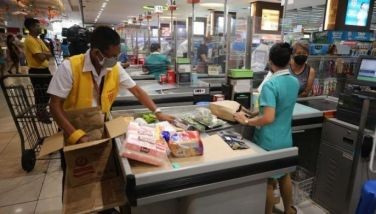HSBC sees Philippines growth slowing to 4.4% in 2023

MANILA, Philippines — British banking giant HSBC sees a sharp economic growth slowdown in the Philippines as the tightening cycle of the Bangko Sentral ng Pilipinas (BSP) would curtail consumption, which is a major growth driver.
James Cheo, HSBC Global Private Banking and Wealth chief investment officer for Southeast Asia, said in a virtual press briefing that the gross domestic product (GDP) growth of the Philippines is set to slacken to 4.4 percent this year.
Cheo pointed out that the projected slowdown in global trade would provide a “little bit of a headwind for the Philippines.”
“Looking into 2023, the country’s growth will slow and the recovery is going to be more gradual as the reopening boost fades and monetary tightening weighs on domestic demand. Due to the high inflation, particularly food inflation, household’s consumption in 2023 will likely be curtailed,” Cheo said.
According to Cheo, strong employment, tourism recovery, expanding production and retail sales, and public investment would continue to support growth this year.
“But I think by and large, I would say that, given the potential growth of Philippines always very high potentially because you have a young working population, and because of that potential growth is always higher than most countries,” Cheo said.
The Philippines exited the pandemic-induced recession with a GDP growth of 5.7 percent in 2021, reversing the 9.6 percent contraction in 2020 when the economy stalled due to strict COVID-19 quarantine and lockdown protocols.
The country managed to sustain the momentum with a GDP expansion of 7.7 percent from January to September last year as the economy further reopened.
“The Philippine economy has been driven by robust private consumption, investment, and by sustained public infrastructure spending. Increased mobility, especially after the resumption of face-to-face schooling, is underpinning a recovery in domestic demand,” Cheo noted.
He highlighted that HSBC is neutral on the country’s equity market as monetary policy is still expected to tighten and growth to slow down.
“We are neutral on Philippines equity market for now. Consensus growth for the stock market remains healthy for 2023. The stock market’s valuation is trading below its historical average. We think opportunities in the Philippines stock market will be in selected consumer companies and banks,” he said.
HSBC Global Private Banking and Wealth chief investment officer for Asia Fan Cheuk Wan said the region stands out as the only region projected to deliver growth acceleration this year amid peaking interest rates, a weaker US dollar, China’s economic reopening, and solid ASEAN growth.
“We see silver linings in the Asian market outlook for 2023 due to peaking US rates, a softer US dollar, and China’s improved recovery outlook,” Fan said.
After China made two significant policy pivots to ease the zero COVID restrictions and step up funding support for the property market, HSBC now forecast China GDP growth to rebound to five percent this year and further accelerate to 5.8 percent next year from three percent last year.
“Another important supportive driver for the Asian markets is resilient performance of the ASEAN economies, which benefit from the global supply chain reorientation, stronger intra-regional trade, and China’s economic reopening,” Fan said.
Fan pointed out that the British bank sees global GDP growth decelerating to 1.9 percent in 2023 from three percent in 2022 while global inflation would moderate to 6.6 percent from 8.4 percent as a result of hawkish central banks, led by the US Federal Reserve, tightening over the past year.
Against the backdrop of synchronized global downturn, Fan said Asia would stand out as the outperformer with a faster GDP growth of 4.3 percent this year from last year’s 3.5 percent, driven by economic reopening in mainland China and Hong Kong, as well as solid growth in the ASEAN region.
“We believe the US dollar bull run has come to an end on the back of peaking US rates. Rate differentials between the US dollar and other G10 currencies are unlikely to widen further, and this removes the main tailwind for US dollar,” she said.
- Latest
- Trending































